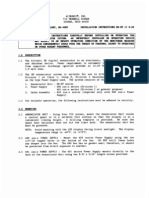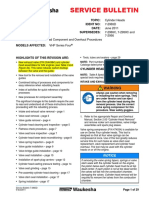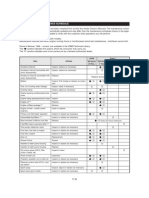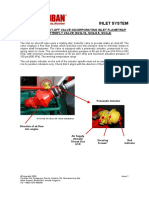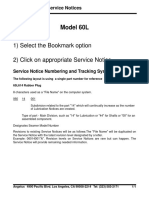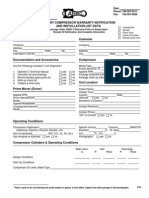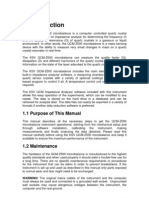Er 82
Er 82
Uploaded by
michaelxiaoCopyright:
Available Formats
Er 82
Er 82
Uploaded by
michaelxiaoOriginal Description:
Original Title
Copyright
Available Formats
Share this document
Did you find this document useful?
Is this content inappropriate?
Copyright:
Available Formats
Er 82
Er 82
Uploaded by
michaelxiaoCopyright:
Available Formats
ENGINEERING REFERENCE
The contents of this document are proprietary and confidential. They are the
property of Ariel Corporation and may not be disclosed, reproduced, or used for
manufacture in part or in whole without written permission from Ariel Corporation.
Soft Foot and Top Plane Flatness Checks for
Proper Main Bearing Bore Alignment in
Reciprocating Compressors
Main bearing bore alignment is critical to main bearing and crankshaft life. Ariel manufactures the top
cover mounting surface of a compressor frame in close tolerance to a flat plane, to the main bearing
bores, and to the bottom of the compressor feet. The main bearing bores align when frame feet are
supported so the top cover mounting surface is flat and "in plane". Perform a soft foot check and top
plane flatness measurement at these times:
Setting of a new compressor (pre and post grouting).
Commission of a compressor in the field.
Reinstallation of a compressor.
Relocation of a package.
Discovery of loose hold down fasteners.
Performance of recommended scheduled maintenance inspection every 6 months or 4000 hours.
With new unit installations, Ariel recommends checking and recording initial top plane flatness before
shimming the guide feet and after initial rough coupling alignment. On compressors shipped
disassembled, perform the initial check before guide and cylinder assembly installation. Shim or
otherwise adjust the height to bring the top cover mounting surface within the specified plane tolerance.
Record subsequent readings after complete guide and cylinder installation, and again after any vessel
installation and shimming. Re-adjust height if guide, cylinder, and/or vessel installation results in frame
top rail measurements out of TABLE 1 tolerances.
JGB:V:Z:U and KBB:V:Z:U 4 and 6-throw frames require both a top plane flatness and soft foot
checks. For all other frames, the soft foot check is required; the top plane flatness measurement is
optional, except for the JGI, which requires none.
Use the procedure below to properly install and periodically inspect compressor frames.
1. To check soft foot, properly install and torque compressor frame hold down bolting. Loosen each
hold down bolt individually while checking the frame foot to skid deflection with a calibrated dial indicator. Correct any hold down position that deflects more than 0.002 inches (0.05 mm) when
released. Re-torque the hold down bolt and repeat on each frame-to-skid bolt. See ER-26 for
proper frame foot and crosshead guide bolt size and torques.
2. Remove or reposition the top cover(s) and gasket(s) to expose the frame top cover mounting surface. Verify it is clean.
NOTE: For KBZ:U frames only, the frame top rail has been coated with a light coat of Cortec VPCI 369 corrosion inhibitor or equivalent to protect the aluminum to cast iron joint.
If the top cover is removed, clean both the top rail and the top cover and re-coat the
frame top rail with a light coat of the same compound. If VPCI 369 or equivalent is not
For the most recent edition of this document, visit www.arielcorp.com.
Transferred document to Flare, Added links to referenced documents. Added "F" to
all references of JGC:D frames.
REV
Page 1 of 2
DESCRIPTION
REV 8
4
3
2
1
0
REV
016003
015114
014434
014236
010374
EC
5-19-09
6-13-08
10-30-07
3-19-07
11-13-06
DATE
8
7
6
5
REV
019144
015759
016770
015718
EC
11-6-13
4-28-11
6-9-10
6-17-09
DATE
ER-82
ENGINEERING REFERENCE
The contents of this document are proprietary and confidential. They are the
property of Ariel Corporation and may not be disclosed, reproduced, or used for
manufacture in part or in whole without written permission from Ariel Corporation.
available, use marine grade grease. Apply only a light coat of the corrosion inhibitor; do
not allow excess material to flow into the frame when the top cover is installed.
3. To check top plane flatness, use measurement equip- TABLE 1 Top Plane Flatness Tolerances
ment with a published accuracy of +0.001 inches
(0.025 mm) over the distance required to measure the
Tolerance
Compressor Framea
entire length of both frame rails. Measure the top surInch (mm)
face of both sides of the frame rails at each anchor
JGM:N:P:Q/1/2. JG:A/2/4,
0.004 (0.10)
JGR:J/2
bolt (see FIGURE 1), or between each pair of anchor
JGA/6, JGR/4, JGJ/4/6,
bolts for frames with pairs of anchor bolts (see FIGJGH:E:K:T:C:D:F:Z:U/2/4,
0.006 (0.15)
URE 2). Readings between any two adjacent points
JGB:V/4a,KBZ:U/2/4, KBB:V/4
must be within 0.002 in. (0.05 mm). For proper alignJGE:K:T/6, JGC:D:F/6,
ment, total accumulated out of plane flatness must be
JGZ:U/6, JGB:V/6,
0.008 (0.20)
within TABLE 1 tolerances.
KBB:V:Z:U/6
NOTE: If the unit will not be restarted immediately, re-preserve the unit in a manner appropriate to the time duration until restart.
a. Underlined frames require both soft foot and top
plane flatness checks.
FIGURE 1 Flatness Check Locations for Frames with Single Anchor Bolts
FIGURE 2 Flatness Check Locations for Frames with Pairs of Anchor Bolts
Page 2 of 2
REV 8
ER-82
You might also like
- 0-WD380-EP200-00004 - Rev.A Steel Flanges Tech. Spec.No ratings yet0-WD380-EP200-00004 - Rev.A Steel Flanges Tech. Spec.34 pages
- ER-82 EN Soft Foot and Top Plane Flatness Checks PDFNo ratings yetER-82 EN Soft Foot and Top Plane Flatness Checks PDF3 pages
- ALTRONIC DD Series Annunciator Installation InstructionsNo ratings yetALTRONIC DD Series Annunciator Installation Instructions14 pages
- Alignment For A Reciprocating CompressorNo ratings yetAlignment For A Reciprocating Compressor2 pages
- Data, Ratings & Clearances For Ajax EnginesNo ratings yetData, Ratings & Clearances For Ajax Engines15 pages
- Ariel Is Pleased To Announce The Production Release of The All New KBK:TNo ratings yetAriel Is Pleased To Announce The Production Release of The All New KBK:T2 pages
- Tier 4 I E E A I Manual C4.4 To C 7.1 Industrial Products TPD1726E1No ratings yetTier 4 I E E A I Manual C4.4 To C 7.1 Industrial Products TPD1726E129 pages
- ER-93 EN Leveling Limits For Stationary Reciorocanting Compressor PDFNo ratings yetER-93 EN Leveling Limits For Stationary Reciorocanting Compressor PDF2 pages
- Altronic DD20 Annunciator and TachmotersNo ratings yetAltronic DD20 Annunciator and Tachmoters31 pages
- Guideline For: Specifications and Salvage For Spacer Plates On 3500 EnginesNo ratings yetGuideline For: Specifications and Salvage For Spacer Plates On 3500 Engines9 pages
- Grafica de Medidas para Recesion de Valvulas G3400No ratings yetGrafica de Medidas para Recesion de Valvulas G34003 pages
- 2D) SVG Inlet Valve SVG-12, SVG-9.5, SVG-4No ratings yet2D) SVG Inlet Valve SVG-12, SVG-9.5, SVG-44 pages
- AJI20024 Ajax Integral Engine Compressor DPC 2804 r0 WebNo ratings yetAJI20024 Ajax Integral Engine Compressor DPC 2804 r0 Web2 pages
- LEBW4958-07 - Crankcase Ventilation SystemNo ratings yetLEBW4958-07 - Crankcase Ventilation System22 pages
- Cranesmart V4 LMI User Manual September 16 2019No ratings yetCranesmart V4 LMI User Manual September 16 2019129 pages
- Technical Information Bulletins Ajax # 010717100% (1)Technical Information Bulletins Ajax # 01071728 pages
- Plymouth and Chrysler-built cars Complete Owner's Handbook of Repair and MaintenanceFrom EverandPlymouth and Chrysler-built cars Complete Owner's Handbook of Repair and MaintenanceNo ratings yet
- Vendor Literature Selection For Reciprocating Compressor Customer ManualsNo ratings yetVendor Literature Selection For Reciprocating Compressor Customer Manuals2 pages
- Leveling Limits For Stationary Reciprocating Compressors: Engineering ReferenceNo ratings yetLeveling Limits For Stationary Reciprocating Compressors: Engineering Reference2 pages
- Rotary Compressor Warranty Notification and Installation List DataNo ratings yetRotary Compressor Warranty Notification and Installation List Data1 page
- ARIEL AR282 Rotary Screw Compressor: Capacity, m3/hr 2211 To 5317 1972 To 4744No ratings yetARIEL AR282 Rotary Screw Compressor: Capacity, m3/hr 2211 To 5317 1972 To 47442 pages
- MEC301 Heat and Mass Transfer 16116::sachin Sharma 4.0 1.0 0.0 5.0 Courses With Numerical and Conceptual FocusNo ratings yetMEC301 Heat and Mass Transfer 16116::sachin Sharma 4.0 1.0 0.0 5.0 Courses With Numerical and Conceptual Focus8 pages
- Double SST74-SCANIA R580 (T1148AR3-1506010)No ratings yetDouble SST74-SCANIA R580 (T1148AR3-1506010)4 pages
- Liebherr P 995 Litronic Operation and Maintenance Manual100% (1)Liebherr P 995 Litronic Operation and Maintenance Manual128 pages
- Types and Features of Rolling Bearings PDFNo ratings yetTypes and Features of Rolling Bearings PDF6 pages
- Eliminator Torsion Axles: Shock Cord Cross SectionNo ratings yetEliminator Torsion Axles: Shock Cord Cross Section23 pages
- Eric Esarey Et Al - Overview of Plasma-Based Accelerator ConceptsNo ratings yetEric Esarey Et Al - Overview of Plasma-Based Accelerator Concepts37 pages
- Lampiran 4: Uji Validitas Dan Reliabilitas: Reliability StatisticsNo ratings yetLampiran 4: Uji Validitas Dan Reliabilitas: Reliability Statistics2 pages
- Case: Sweetwater: Sathiya Singh V 1501039No ratings yetCase: Sweetwater: Sathiya Singh V 15010392 pages
- ME320L N Elevator Specialized Inverter User ManualNo ratings yetME320L N Elevator Specialized Inverter User Manual127 pages





